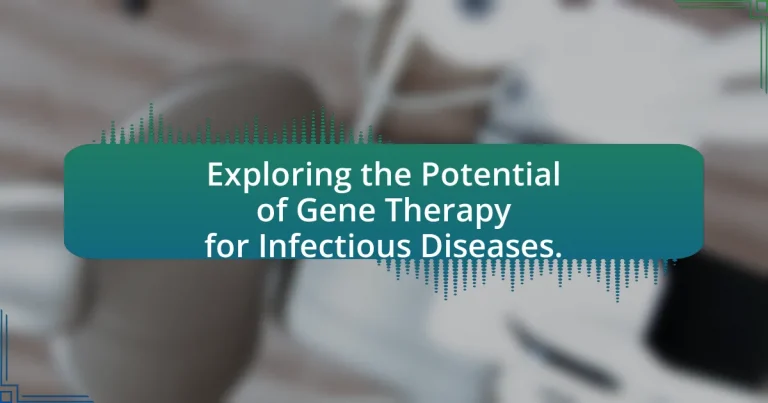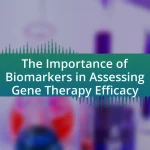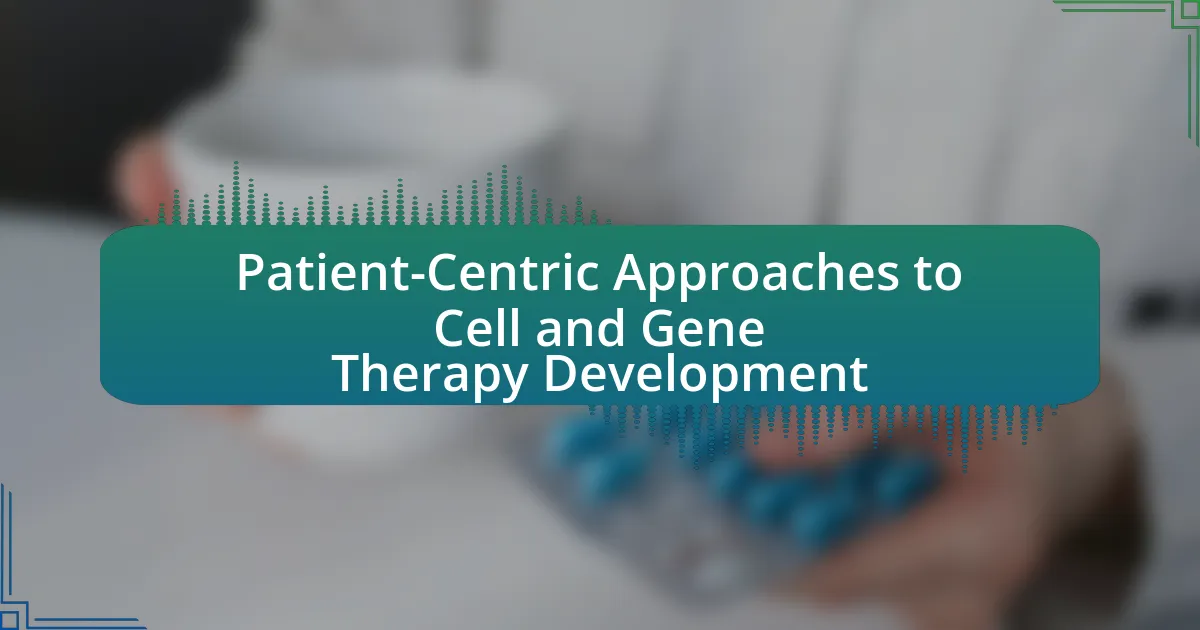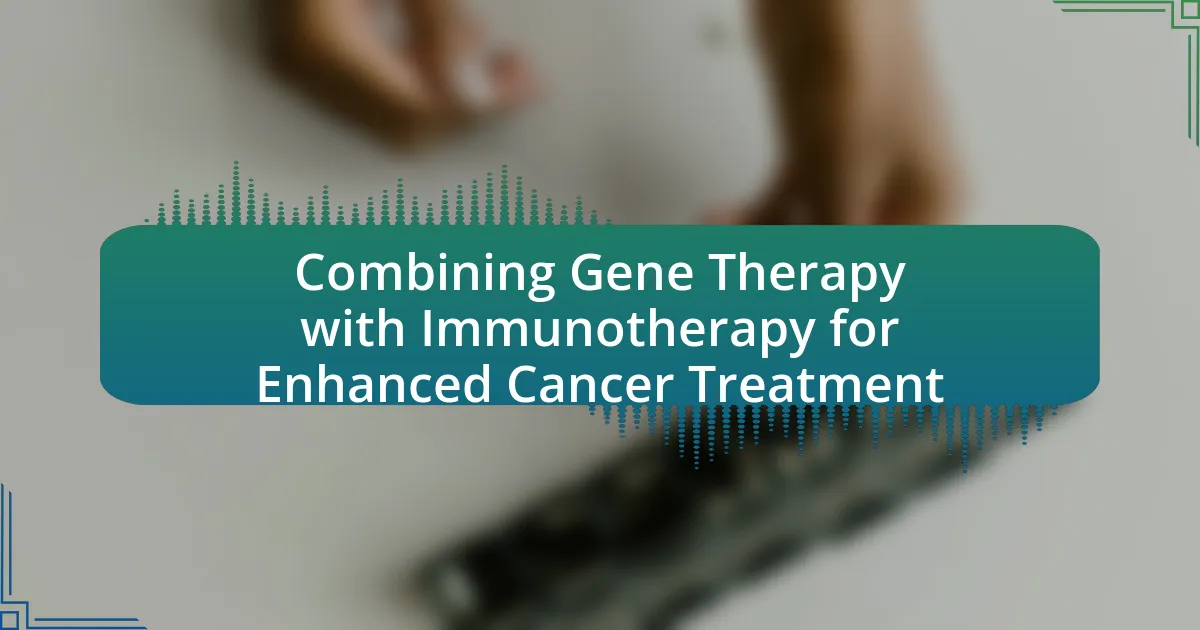Gene therapy for infectious diseases represents a groundbreaking medical approach that modifies patient cell genes to treat or prevent infections by enhancing immune responses against pathogens. This article explores the mechanisms of gene therapy, including gene replacement, editing, and silencing, as well as the role of viral vectors in delivering therapeutic genes. It discusses the potential applications of gene therapy for various viral and bacterial infections, the advantages over traditional treatments, and the challenges faced in its development. Additionally, the article highlights recent breakthroughs, ongoing clinical trials, and the importance of collaboration across sectors to improve gene therapy outcomes in combating infectious diseases.

What is Gene Therapy for Infectious Diseases?
Gene therapy for infectious diseases is a medical approach that involves modifying the genes of a patient’s cells to treat or prevent infections. This innovative technique aims to enhance the immune response against pathogens, such as viruses and bacteria, by introducing genetic material that can either boost the immune system’s ability to fight off infections or directly target and eliminate the infectious agents. For instance, research has demonstrated that gene therapy can be used to deliver antiviral genes that inhibit viral replication, as seen in studies targeting HIV and hepatitis B.
How does gene therapy target infectious diseases?
Gene therapy targets infectious diseases by introducing genetic material into a patient’s cells to combat pathogens or enhance the immune response. This approach can involve delivering genes that encode for antiviral proteins, which inhibit viral replication, or genes that enhance the immune system’s ability to recognize and destroy infected cells. For instance, research has demonstrated that gene therapy can be used to treat HIV by inserting genes that produce proteins capable of blocking viral entry into cells, effectively reducing viral load. Additionally, studies have shown that using gene editing technologies like CRISPR can directly target and disrupt the genomes of bacteria or viruses, providing a precise method to eliminate infections.
What are the mechanisms of action in gene therapy?
Gene therapy primarily operates through several mechanisms, including gene replacement, gene editing, and gene silencing. Gene replacement involves introducing a healthy copy of a gene to compensate for a defective one, which can restore normal function in cells. Gene editing, often utilizing technologies like CRISPR-Cas9, allows for precise alterations to the DNA sequence, correcting mutations at specific locations. Gene silencing employs techniques such as RNA interference to inhibit the expression of harmful genes, effectively reducing the impact of diseases. These mechanisms have been validated in various studies, demonstrating their potential in treating genetic disorders and infectious diseases by targeting the underlying causes at the molecular level.
How do viral vectors play a role in gene therapy?
Viral vectors are essential tools in gene therapy as they facilitate the delivery of therapeutic genes into target cells. These vectors, derived from viruses, are engineered to be non-pathogenic while retaining their ability to efficiently enter cells and transfer genetic material. For instance, adenoviruses and lentiviruses are commonly used viral vectors that can carry genes into human cells, enabling the expression of proteins that can correct genetic defects or combat infectious diseases. Studies have shown that using viral vectors can significantly enhance the efficacy of gene therapy, as evidenced by clinical trials demonstrating successful treatment outcomes in conditions like cystic fibrosis and certain types of cancer.
What types of infectious diseases can gene therapy address?
Gene therapy can address various infectious diseases, including viral infections such as HIV, hepatitis B, and herpes simplex virus. For instance, gene therapy techniques like CRISPR have been utilized to target and disrupt the DNA of HIV within infected cells, demonstrating potential in reducing viral loads. Additionally, studies have shown that gene therapy can enhance the immune response against hepatitis B by introducing genes that encode for specific antigens, thereby promoting a stronger immune reaction. These applications highlight the capacity of gene therapy to modify host responses and directly target pathogens, offering innovative treatment avenues for infectious diseases.
Which viral infections are potential targets for gene therapy?
Viral infections that are potential targets for gene therapy include HIV, Hepatitis B, Hepatitis C, and certain types of herpesviruses. Gene therapy approaches aim to modify or replace genes to combat these infections effectively. For instance, research has shown that gene editing techniques like CRISPR can target the HIV genome, potentially leading to functional cures. Additionally, studies have indicated that gene therapy can reduce viral loads in Hepatitis B and C patients by targeting viral replication mechanisms. These examples demonstrate the feasibility and ongoing exploration of gene therapy as a treatment for various viral infections.
How can gene therapy be applied to bacterial infections?
Gene therapy can be applied to bacterial infections by utilizing techniques that modify the genetic material of bacteria or host cells to combat the infection. One approach involves using engineered bacteriophages, which are viruses that specifically target and kill bacteria, to deliver therapeutic genes that can disrupt bacterial function or enhance the immune response. For instance, studies have shown that introducing genes encoding antimicrobial peptides into host cells can increase their ability to fight off bacterial pathogens, thereby reducing infection severity. Additionally, gene editing technologies like CRISPR can be employed to target and disable specific bacterial genes, rendering the bacteria less virulent or more susceptible to antibiotics. These methods demonstrate the potential of gene therapy to provide innovative solutions for treating bacterial infections, as evidenced by ongoing research and clinical trials exploring these applications.
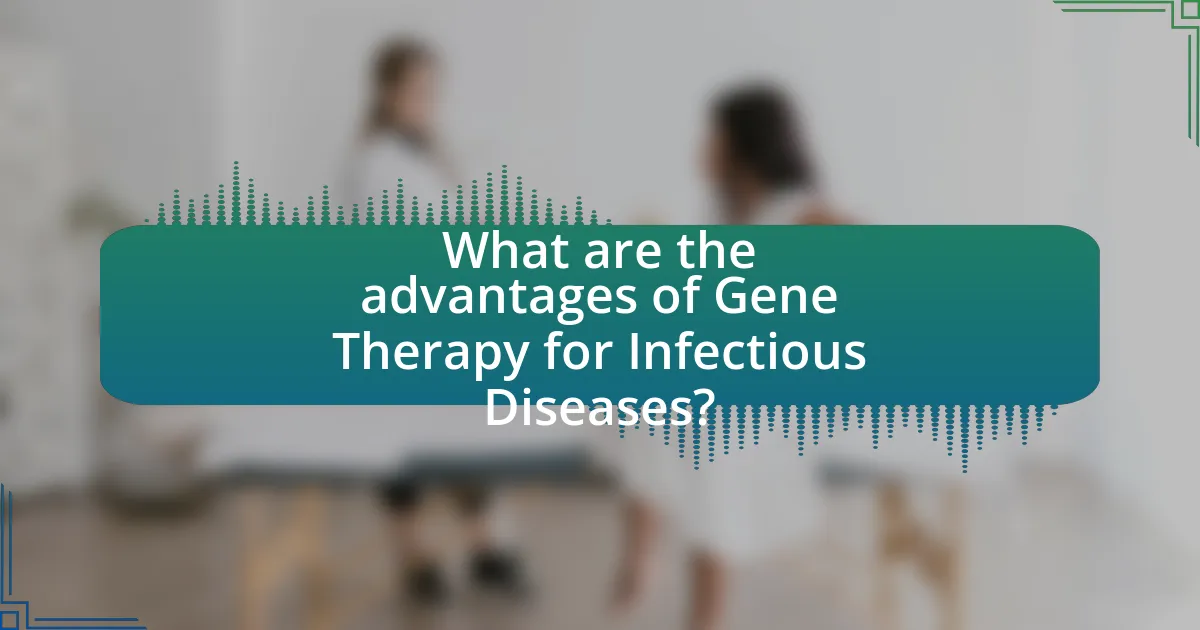
What are the advantages of Gene Therapy for Infectious Diseases?
Gene therapy offers significant advantages for treating infectious diseases by enabling targeted interventions at the genetic level. This approach can directly modify the host’s immune response, enhancing its ability to combat pathogens. For instance, gene therapy can introduce genes that encode for antiviral proteins, which can inhibit viral replication, as demonstrated in studies involving HIV and hepatitis B. Additionally, gene therapy can potentially provide long-lasting immunity by integrating therapeutic genes into the host genome, reducing the need for repeated treatments. This method has shown promise in clinical trials, where patients exhibited sustained viral suppression after receiving gene therapy, highlighting its effectiveness in managing chronic infections.
How does gene therapy improve treatment outcomes?
Gene therapy improves treatment outcomes by directly targeting and correcting genetic defects that cause diseases. This approach allows for the restoration of normal function in affected cells, leading to more effective and potentially curative treatments. For instance, in conditions like cystic fibrosis, gene therapy can introduce a functional copy of the CFTR gene, significantly improving lung function and quality of life for patients. Clinical trials have demonstrated that patients receiving gene therapy for inherited retinal diseases have shown improved vision, highlighting the therapy’s ability to address the root cause of the disease rather than just alleviating symptoms.
What are the long-term benefits of gene therapy compared to traditional treatments?
Gene therapy offers significant long-term benefits over traditional treatments by providing a potential cure rather than merely managing symptoms. Unlike traditional treatments, which often require ongoing administration and can lead to side effects, gene therapy aims to correct the underlying genetic defects responsible for diseases, potentially leading to permanent solutions. For instance, in the case of inherited disorders like cystic fibrosis, gene therapy has shown the ability to restore normal function to affected cells, which can result in improved quality of life and reduced healthcare costs over time. Studies have demonstrated that patients receiving gene therapy for conditions such as spinal muscular atrophy have experienced sustained improvements in motor function and survival rates, highlighting the long-term efficacy of this approach compared to conventional therapies that do not address the root cause of the disease.
How does gene therapy reduce the risk of drug resistance?
Gene therapy reduces the risk of drug resistance by directly targeting and modifying the genetic material of pathogens or host cells to enhance therapeutic efficacy. This approach can introduce genes that encode for proteins capable of neutralizing drug resistance mechanisms, thereby restoring the effectiveness of existing treatments. For instance, gene therapy can be used to deliver genes that produce enzymes to break down resistance-conferring proteins in bacteria, as demonstrated in studies where engineered bacteria showed reduced resistance to antibiotics. By addressing the genetic basis of resistance, gene therapy offers a novel strategy to circumvent the limitations of traditional drug therapies.
What challenges does gene therapy face in treating infectious diseases?
Gene therapy faces significant challenges in treating infectious diseases, primarily due to issues related to delivery mechanisms, immune responses, and the complexity of pathogens. Delivery mechanisms often struggle to effectively target and penetrate infected cells, limiting the therapeutic impact of gene therapies. Additionally, the immune system may recognize the introduced genetic material as foreign, leading to an immune response that can neutralize the therapy before it exerts its effects. Furthermore, the genetic diversity and adaptability of pathogens complicate the development of effective gene therapies, as treatments may need to be tailored to specific strains or variants. These challenges highlight the need for ongoing research and innovation in gene therapy approaches for infectious diseases.
What are the ethical considerations surrounding gene therapy?
The ethical considerations surrounding gene therapy include issues of consent, equity, and potential long-term effects. Informed consent is crucial, as patients must fully understand the risks and benefits before undergoing treatment. Equity concerns arise from the potential for unequal access to gene therapies, which could exacerbate existing health disparities. Additionally, the long-term effects of gene therapy are not yet fully understood, raising questions about unintended consequences and the implications of altering human genetics. These considerations are vital for ensuring responsible development and application of gene therapy in treating infectious diseases.
How do regulatory hurdles impact the development of gene therapy?
Regulatory hurdles significantly delay the development of gene therapy by imposing stringent requirements for safety and efficacy. These regulations often necessitate extensive preclinical and clinical trials, which can prolong the timeline for bringing therapies to market. For instance, the U.S. Food and Drug Administration (FDA) mandates rigorous testing protocols, which can take years to complete, thereby increasing costs and limiting the number of projects that can be pursued simultaneously. Additionally, the complexity of gene therapy products, such as viral vectors, requires specialized regulatory pathways, further complicating the approval process. This regulatory landscape can deter investment and innovation in the field, as companies may be hesitant to commit resources to therapies with uncertain approval timelines.
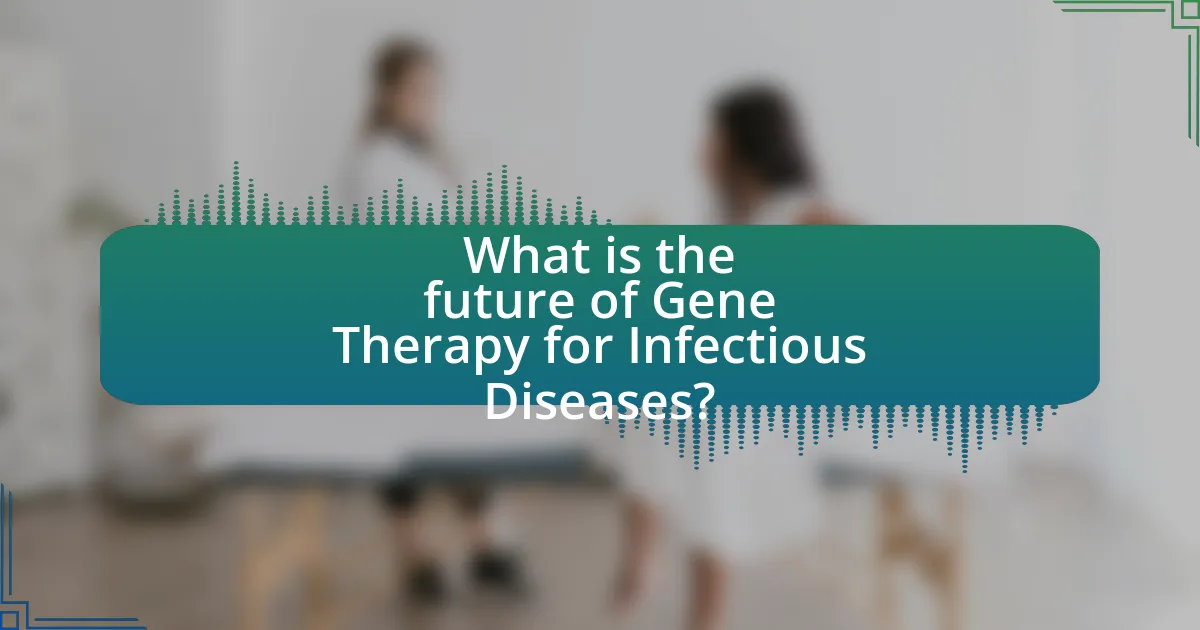
What is the future of Gene Therapy for Infectious Diseases?
The future of gene therapy for infectious diseases is promising, with advancements in technology enabling targeted treatments that can effectively combat viral and bacterial infections. Recent developments, such as CRISPR-Cas9 gene editing, have shown potential in eliminating pathogens at the genetic level, as evidenced by studies demonstrating its efficacy against HIV and hepatitis B. Furthermore, ongoing clinical trials are exploring the use of gene therapy to enhance immune responses, which could lead to more effective vaccines and therapies for diseases like tuberculosis and malaria. These innovations suggest a transformative impact on how infectious diseases are treated, potentially reducing reliance on traditional pharmaceuticals and improving patient outcomes.
How is research advancing in the field of gene therapy?
Research is advancing in the field of gene therapy through innovative techniques such as CRISPR-Cas9, which allows for precise editing of genes to correct genetic disorders. Recent studies have demonstrated the successful application of gene therapy in treating conditions like spinal muscular atrophy and certain types of inherited blindness, showcasing its potential to address previously untreatable diseases. For instance, a clinical trial published in the New England Journal of Medicine in 2020 reported that a single dose of a gene therapy for spinal muscular atrophy led to significant improvements in motor function in infants. Additionally, advancements in viral vector design and delivery methods are enhancing the efficacy and safety of gene therapies, making them more viable for a broader range of infectious diseases.
What are the latest breakthroughs in gene therapy for infectious diseases?
Recent breakthroughs in gene therapy for infectious diseases include the development of CRISPR-based approaches to target and eliminate viral genomes, such as those of HIV and hepatitis B. For instance, a study published in Nature in 2022 demonstrated the use of CRISPR-Cas9 to excise HIV DNA from infected cells, effectively reducing viral loads in animal models. Additionally, researchers have made strides in using adeno-associated viruses (AAV) to deliver therapeutic genes that enhance the immune response against pathogens like Zika and dengue viruses. These advancements indicate a significant potential for gene therapy to provide long-lasting solutions to infectious diseases by directly targeting the pathogens or enhancing host immunity.
How are clinical trials shaping the future of gene therapy?
Clinical trials are pivotal in shaping the future of gene therapy by providing essential data on safety, efficacy, and optimal delivery methods. These trials enable researchers to evaluate innovative gene-editing techniques, such as CRISPR, in treating infectious diseases, thereby advancing therapeutic options. For instance, the ongoing clinical trials for gene therapies targeting HIV have shown promising results, with studies indicating that gene editing can effectively disrupt the virus’s ability to replicate. This evidence supports the potential for gene therapy to revolutionize treatment paradigms for infectious diseases, moving from traditional methods to more targeted, genetic approaches.
What practical steps can be taken to enhance gene therapy applications?
To enhance gene therapy applications, researchers should focus on improving vector delivery systems, optimizing gene editing technologies, and ensuring precise targeting of affected cells. Enhanced vector delivery systems, such as adeno-associated viruses (AAVs) or lipid nanoparticles, can increase the efficiency of gene transfer and reduce immune responses. Optimizing gene editing technologies, like CRISPR-Cas9, allows for more accurate modifications with fewer off-target effects, which is crucial for safety and efficacy. Additionally, ensuring precise targeting of affected cells minimizes unintended consequences and maximizes therapeutic benefits. These steps are supported by studies demonstrating improved outcomes in clinical trials when advanced delivery methods and precise editing techniques are employed.
What best practices should researchers follow in gene therapy development?
Researchers in gene therapy development should prioritize safety, efficacy, and ethical considerations. Ensuring patient safety involves rigorous preclinical testing and adherence to regulatory guidelines, such as those set by the FDA and EMA, which mandate comprehensive risk assessments. Efficacy must be demonstrated through well-designed clinical trials that utilize appropriate endpoints and control groups, as evidenced by the success of therapies like Luxturna, which treats inherited retinal disease and has undergone extensive clinical validation. Ethical considerations include obtaining informed consent and ensuring equitable access to therapies, as highlighted by the need for transparency in trial protocols and participant recruitment. These best practices are essential for advancing gene therapy while maintaining public trust and scientific integrity.
How can collaboration between sectors improve gene therapy outcomes?
Collaboration between sectors can significantly improve gene therapy outcomes by integrating diverse expertise and resources, leading to more effective treatment strategies. For instance, partnerships between academia, industry, and healthcare can facilitate the translation of research findings into clinical applications, enhancing the development of innovative gene therapies. A study published in “Nature Biotechnology” by K. K. Wong et al. (2020) highlights that interdisciplinary collaboration accelerates the identification of novel therapeutic targets and optimizes delivery mechanisms, ultimately improving patient outcomes. Furthermore, sharing data and best practices across sectors fosters a more comprehensive understanding of disease mechanisms, which is crucial for tailoring gene therapies to specific infectious diseases.
